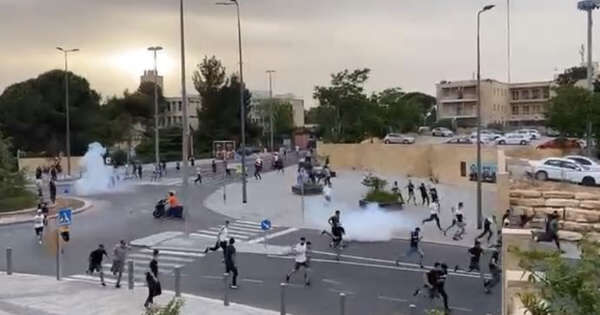Motivation
The Puzzling Effect of Threat Perceptions During Conflict
Exploring the link between threat and public opinion in conflict zones.
Posted October 21, 2021 Reviewed by Tyler Woods
Key points
- Assessing a threat comprises two elements: Assessment of the likelihood that adversity will occur and assessment of its severity.
- We show that during conflict, people who are threatened by the likelihood of violence tend to oppose compromising with their rivals
- However, those whose threats stemmed mainly from the severity of violence tend to support compromises.
- It seems that the fears and threats of people living in conflict zones have far-reaching effects, including thier support or opposition to peace
Take a look at the image below. The photo depicts Palestinian protesters running away from tear-gas grenades fired by Israeli forces. It might be hard to believe, but the picture was taken 100 yards from our lab.

Our lab (the Psychology of Intergroup Conflict and Reconciliation Lab, a.k.a. the PICR lab) is located at the Hebrew University's Mount Scopus Campus, in Jerusalem. The campus is about 200 yards from the border between West Jerusalem (i.e., Israel proper) and East Jerusalem (i.e., the Occupied Palestinian Territories). The clashes seen in the picture started in the wake of new restrictions imposed by the Israeli government on East Jerusalem Palestinians. Looking at the picture, it is quite apparent that we study the psychology of intergroup relations from the heart of a live and violent conflict.
Anyone who has lived in a conflict zone and experienced conflict-related violence is familiar with the threat and fear of its reoccurrence. In this post, we want to focus on the experience of threat during conflict, or more accurately, on the psychological mechanisms of threat perception and how they impact public opinion.
Peoples' threat from future violence shapes their attitudes towards a host of issues, from deciding to emigrate from their conflict-ridden country to their stance on peace negotiations and war. However, scholars are divided about the direction of this influence, especially when it comes to public support for policies aimed to promote peacebuilding and compromise (also termed dovish policies).
Two opposite predictions about the relationship between perception of threat and support for dovish policies can be made. First, it stands to reason that the more people are threatened by the reoccurrence of violence, the more they'll support dovish policies because the destruction and suffering evoked by conflict-related violence make peace seem more desirable and urgent. In other words, dreading violence and war is likely to increase support for peacebuilding and compromise.
At the same time, citizens' threats from the reoccurrence of violence may diminish support for dovish policies because peace seems utterly impossible when violence is expected to increase. Here, threats from future violence are likely to decrease the belief in the feasibility of peace and, in turn, dwindle the motivation to support peacebuilding and concession making.
Indeed, results from existing studies on the link between citizens' perceived threat from violence and their support for conflict-related policies are not conclusive. In some studies, increased threat from conflict-related violence was associated with stronger opposition to dovish policies (e.g., Gordon & Arian, 2001). In other studies, threat was associated with greater support for dovish policies (e.g., Sandler et al., 2005).
We argue that these inconsistencies could be solved by looking at how threat perceptions are constructed. Simply put, when people assess a threat, they assess two separate dimensions. The first is the likelihood that an adverse event will occur, and the second is the severity of harm perceived to be caused by the adverse event. These two appraisals are combined to form an overall perception of threat.
Let's look at how people living in conflict zones construct their perceptions of threat from the recurrence of violence. First, they judge the likelihood of escalation. Some might think that escalation is very probable, even inevitable, while others may think that future violence is not that likely. They also estimate the potential severity of future violence. Some might perceive future violence as extremely horrific and unbearable, whereas others may envision escalation in less intense terms.
We theorized that threat stemming from perceiving future violence as likely generates opposition to dovish policies because believing that future violence is probable lowers the belief in the possibility of peace and thus decreases the motivation to support compromise. At the same time, threat that stems from perceiving future violence as severe increases support for the same policies because the pain and anguish associated with severe violence increase the urgency to hasten peace, even at the price of compromise.
Our theory was supported by a study we conducted among 800 participants from Israel and the Palestinian Territories (Leshem & Halperin, 2021, Political Behavior). The study showed that Israelis and Palestinians who were more concerned about the likelihood of violence than its severity tended to oppose dovish policies. In contrast, those whose concerns stemmed from the severity of violence (rather than its likelihood) tended to support the same policies.
Our data also provided an explanation for these findings. It showed that perceiving violence as probable reduces the belief in the feasibility of peace and consequently decreases the motivation to support peacebuilding initiatives and compromise. At the same time, the more concerned people were with the severity of violence, the more they thought that peace was urgent and, in turn, the more they were eager to support peace-promoting policies.
These findings explain the inconsistencies from past studies exploring the link between threat and policy preference during conflict. Yet, a question remains concerning the generalizability of the results. Will these findings replicate in other conflicts?
The decades-long conflict between Turkish and Greek Cypriots shares some similarities with the Israeli-Palestinian case. It involves ethnic and religious factors, international deadlocks, grievances, displacement, and deep mistrust between the rival parties. However, unlike the conflict in Israel-Palestine, the Cypriot dispute has been violence-free for approximately twenty years. Will our model linking perception of threat and support for dovish policies hold in a place where violence has been dormant for years?
Data collected among more than 1,000 Turkish and Greek citizens from the divided island demonstrates that our model replicates perfectly. Cypriots whose perception of threat stemmed from expecting a future escalation were less supportive of dovish policies than Cypriots whose threat perception stemmed primarily from perceiving future escalation as severe.
What is the overall take-home message of these studies? Most importantly they show that people's perception of threat from conflict and violence comprises two appraisals (likelihood and severity of escalation), each having an opposite impact on how those mired in conflict think and react. Additionally, the threat experienced by people living in conflict zones has far-reaching effects, such as shaping their support or opposition to peace.

Oded Adomi Leshem, Ph.D., is a Senior Research Associate at the PICR Lab and a Postdoctoral Fellow at the Truman Institute for the Advancement of Peace. His research is located at the nexus of political psychology and conflict resolution with a specialization in violent conflicts. His main areas of interest are international and intranational conflicts, the formation and transformation of political ideologies, and conflict and the media.
References
Gordon, C., & Arian, A. (2001). Threat and decision-making. Journal of Conflict Resolution, 45(2), 196–215
Leshem & Halperin (2021). Threatened by the Worst and Hoping for the Best: Unraveling the Relationship Between Threat, Hope, and Public Opinion during Conflict. Political Behavior
Sadler, M. S., Lineberger, M., Correll, J., & Park, B. (2005). Emotions, attributions, and policy endorsement in response to the September 11th terrorist attacks. Basic & Applied Social Psychology, 27(3), 249–258




